Section 1,
Section 2,
Section 3, Section
4, Section 5, Section 6,
Section 7, Section 8
From:
Ernest Moyer
Sent: Sunday, December 08, 2002 11:26 PM
Subject:
Common Fields of Interest
Martin:
I have been reading
your website with fascination. You are into many areas in which I have also an
intense interest.
(I stumbled across it on a Google search for Assyrian
cubits.)
I respect your intellectual integrity and willingness to admit
ignorance in highly developed, (but not necessarily correct), fields, such as
linguistics. In my opinion the vast body of linguists have gone off the deep end.
I speak from experience, I spent a few months with them in their internet discussion
group. They are an outstanding example of a social consensus that has become delusional.
I would refer you to my website but I fear I would turn you off before you
had an opportunity to more carefully examine my work.
I thought we might
open communications by two recent (still in the process of reworking) papers I
wrote. The first is a refutation of Alexander Thom's Megalithic Yard. I think
he was chasing a self-created myth, inspired by units of measure he cites from
Iberia, etc.
The second is a long narrative, in a somewhat jocular mode,
(I don't want scientists refuting me on my lack of scholarly skill), showing the
origin of the ancient Egyptian cubit. I suspect you might have an intense interest
in my results.
The first paper is short but has a jpg file summarizing
my analysis through histograms I would send as a separate file. Also a table sent
separately if you so desire.
Ernest
Hi Ernest,
....at last, someone who takes an interest in measurement standards used by
ancient civilisations...
I was invited by Mark Newbrook, professor of
Historical Linguistics, to do a full course on the subject (for which I can muster
no great passion or enthusiasm).
If they'd allow it to be opened up a bit
wherein "other influences" were deemed allowable, then the study would
be more interesting. At the moment it's a case of "no transient mariners
allowed" to traverse the Atlantic or Pacific to upset established Historical
Linguistics theory.
The ancient peoples of the Mediterranean, Near East
and Middle East used a far larger parcel of measurement increments than survived
into modern times. The British inch and foot are a part of that very ancient
survival.
In a general sense, I can detect no orphan systems that were
not attached by fluid ratio to each neighboring nation's systems ...they were
all related and had sprung from a single ancient source or master system. See:
http://www.celticnz.co.nz/Weights_Measures_Volumes/Weights_Measures.htm
Amongst the increments, there was one division of 32.4 inches. There was
also copious use of PHI @ approximately 1.6180339 to 1. This can be demonstrated
time and time again within ancient structures including Stonehenge. If PHI was
being incorporated into circle site or edifice geometry, then there would need
to be a PHI based increment or measuring rod.
I believe that Professor
Alexander Thom detected it, although he didn't recognise its true nature. When
he averaged a particular recurring space or interval within British monuments,
which value went on to become his megalithic yard or megalithic rod
measures, he possibly didn't take into account the millenniums of surface wear
of rock faces. He came up with an average of 82.9 centimetres for this interval...or
32.637795 inches for his megalithic yard (MY).
Within the very
ancient integrated systems of metrology, I can find no usage for such a value,
however, I can find tremendous usage of a near value. That value is 32.360678
inches or 20 X PHI. This is, of course, simply taking 20 common inches and
multiplying them by 1.6180339.
I can also see that 32.4 inches (a "rounded"
form of the pure PHI measurement increment) slots into the metrology systems (including
volumes) of countries from Babylon to Britain.
For example: 7
rounded MY @ 32.4 inches each would equal 18 Greek feet @ 12.6 inches each or
11 Egyptian Royal Cubits of 20.61818182 inches (as found in the Turin Museum).
Alternatively, 9 MY @ 32.4 inches would equal 25 Roman feet @ 11.664 inches. This
increment also complies perfectly with known Assyrian or Hebrew measurements.
The Great Pyramid @ 756 feet of base length would be 280 MY of 32.4 inches
each, which is also 440 Egyptian Royal Cubits of 20.61818182 inches each. Khafre
Pyramid @ 15/16ths the length of the Great Pyramid (or 708.75 feet) would be 262.5
MY of 32.4 inches and carry a lunar cycle tracking code in the MY number derived.
It would appear that the ancient people fashioned their metrology systems
in such a way as to include PHI values in a workable form (32.4-inches or a rounded
form of PHI). From this, a pure PHI reading (32.360678-inches or 1.6180339-inches)
was also possible to calculate into every distance (or volume). Therefore, the
Great Pyramid's length could carry dual assignments in rounded PHI (translating
easily into a wide range of standard increments used by all cousin nations) or
pure PHI values.
The use of these values and all others known between
nations was not some kind of intellectual game, but very serious business to do
with readings for navigation, solar-lunar & planetary cycles, calendar systems,
the precession of the equinoxes, etc. The special parcel of numbers, which had
to be remembered at all cost, were also found in the integrated weights and volume
systems in use between cousin nations.
By all means, send your critique
of Thom's results, etc.
Best wishes,
Martin.
From:
Allan Todd.
Sent: Thursday, January 02, 2003 8:35 PM
Subject:
New Zealand history
Hello Martin,
I have just spent the last
5 or 6 hours reading through the emails that have been sent to you. I myself am
not a historian of any sort. I'm just a typical European male of Scottish/German
lineage. Just thought I would say you are doing a good thing with your research
and it's good to see the reverse racism of the few Maori peoples view is not stunting
your ideals of a righteous quest for the truth. I have a keen interest in the
truth of New Zealand's history as well. One question I feel needs to be asked
is that 'If the Maori rendition of New Zealand's history is so true, why is
there such a seemingly desperate need to have a total refusal to let Europeans
investigate our own history within New Zealand?'
Allan Todd
Hamilton, NEW ZEALAND
Hi Allan,
A few years ago I was undertaking
an in-depth study into the design geometry of The
Crosshouse of Miringa Te Kakara and, as a part of the research, sought
out and had an interview with one of New Zealand's leading experts on the Crosshouse.
The gentleman, a European historian with formal establishment credentials and
fully affiliated with the upper echelons of the New Zealand archaeological community,
said the following toward the end of the interview:
'Let history be whatever
the Maori people want it to be. If they wish to believe it was this or that, then
let it be so'.
He gave me the impression that the general attitude
he shared with his colleagues was one where the importance of regional history
was less to do with what had actually happened, in every case, and more to
do with allowing those living in the present to feel pride about themselves, their
ancestors and their accomplishments as a people.
With a very knowing
look, accompanied by enough words for me to get the message, he conveyed that
if certain unhelpful negatives need to be de-emphasised, or conveniently forgotten
and positives exaggerated and embellished, then so be it. It was like saying that
Maori social engineers are at the helm of their own ship and to let them steer
whatever course they wish, or say what they like...and don't disagree or make
waves.
I admit, this attitude was a bit too touchy-feely and paternalistic
for my liking. I prefer the more colourful "warts and all" analysis
of history, accompanied by something called, "the scientific approach".
I
know that archaeology and history are scientific disciplines that can, without
even trying, trample on "sensitivities" and that certain unwanted findings
can have a perceived, detrimental or bruising effect on ethnic pride. Whereas
I'd like everyone to feel a sense of pride in their ancestry and history, I draw
the line when that pride seeks to blockade access to the fuller, true history
related to other ethnic groups who have made a contribution to greater regional
history.
Such a situation describes the impasse we face in New Zealand,
where it's increasingly difficult to clamber over Maori activist political agendas
to get to the earlier evidence. Even Maori groups like Waitaha or Moriori, who
call for "full disclosure", are relegated to the sidelines and silenced.
New
Zealand is a very ancient country. There are many skeletal remains in our burial
caves or sand-dunes that predate Maori by millenniums. These more ancient people
built or erected pre-Celtic style palisaded hill forts in their thousands, raths,
cashels, souterrain dwellings under hills with labyrinths of tunnels, canals,
drainage systems, stonewall compounds, standing stone circles, dolmens, obelisks,
sighting pits, shadow clefts, mounds, earth amphitheatres, stone excavated cliff
dwellings and beehive house villages. They also built gable roof wooden structures
with ornately carved lintels, panels and statuettes that often displayed recognisable
Mediterranean cultural symbolism.
New finds show that they created "cup
stones" for seasonal offerings and fashioned stone "bullaun" bowls
in the surfaces of large boulders for their rituals of convalescence or for use
as "blessing and cursing altars"…just as they did all the way across
Europe, from whence their ancestors came, seemingly in the Megalithic/ Neolithic
Ages.
So, what about my sensitivities? These are my cousin people. I recognise
their handiwork and geometric/ surveying mathematical coding, placed within markers
that are scattered across the length and breadth of New Zealand.
It seems
a little cruel and insensitive that Maori can own the bones of my "Patupaiarehe
and Turehu" people, who were their declared enemies... conquered, enslaved
and stripped of their mana. It's very insulting that Maori can disturb or destroy
these more ancient remains, at will, whenever "problem" graves are located
and need to be rendered "out of sight, out of mind". While acknowledging
that the re-interments are mostly overseen by Kaumatuas and carried out with dignity,
why are Europeans not involved in the relocation process when such remains need
to be moved? I speak, specifically, of remains that display distinct Caucasoid
or European physical traits. Why are these remains not allowed to be studied scientifically?
We are not consulted and have no legal right to intervene or stop the wanton
eradication, suppression or distortion of our ancient European regional history.
Instead, we continue to be told that there was no such history. By the time that
history is acknowledged, many of the traces will be gone...but that, seemingly,
is the agenda of the activists anyway...along with the touchy-feely, turn-a-blind-eye,
overly accomodating, New Zealand academic community.
Best wishes,
Martin.
From:
Allan Todd
Sent: Friday, January 24, 2003 10:38 PM
Subject:
THE TRUTH ABOUT NEW ZEALAND
Hello Martin,
You have raised
a few good points and also a few more questions which I feel need to be asked.
In response to the Historian you speak of regarding the Cross-house of Miringa
Te Kakara - ok, that's a fair enough statement in its own right. To view it from
a different angle though, if that is what the Maori people wish to believe then
that's their choice. As Europeans why can we not believe and promote what we know
to be the truth, and teach it to our children as the Maori version is being taught
to our young? And why has it become compulsory for other ethnicities to learn
about Maori history yet not their own history?
What harm would be done
to the Maori culture by the truth being established or would it just be a blow
to their pride? I definitely don't go for the idea that some one's pride should
take precedence over the actual truth when it comes to the history of a nation.
That to me is a strange and bizarre notion.
Like you, I too prefer the
wart's-and-all approach. If it's not the truth then don't tell me about it.
What I still have not yet worked out is if there is an over-abundance of scientific
proof regarding Celtic relics, pre-Celtic relics and the like, why doesn't the
New Zealand Government release this proof of a more ancient New Zealand history
than what the modern version allows us to know about? Why is all this evidence
being 'swept under the proverbial carpet'?
This whole whitewash/cover-up
gives me the impression that the phrase 'history is built on truth' no longer
means a thing. Why should the truth be hidden to accommodate an incorrect version
of history. Does this mean that by the N.Z government's standards, we as Europeans
are not as important as the Maori people. Is that not a racist attitude in itself?
When will we get recognition for what our ancestors have brought and done for
New Zealand on an official level as part of this country's history?
How much longer will we be denied the truth for the sake of some one else's pride?
It is an absolute insult that Maori have the right to cover up, move and maybe
even destroy the ancient remains left behind by our ancestors. What would happen
if it was Europeans covering up Maori artifacts and not allowing them to investigate
their own history? I feel reasonably secure to say there would be a huge public
upheaval to say the least.
In addition to that, why are these finding's
being moved, under whose authority, where are they being housed and why are they
not being made available to the general public or indeed as you say be studied
scientifically? As I said to you in my first email, I am by no means a historian,
but I'm not stupid either. As I see things, it appears that the Maori are afraid
of the truth. What I feel that's happening here is what I would describe as the
total eradication of the pre-Maori, European history of New Zealand
I don't know what or even if there is anything I can do as a New Zealand citizen
to help preserve our heritage but I am definitely willing to stand up for the
right of the truth to be told. To sit here and know that the remaining traces
of my history are being covered up and/or destroyed for the sake of 'someone's
pride' seems to me a sick joke that desperately needs to be put right before it's
too late.
Regards
Allan Todd
Hamilton
Hi
Allan,
In last Saturday's (Jan 25th 2003) Herald newspaper there was
a full spread called "The Prehistory Dating Game", by Simon
Collins, devoted to the present state of New Zealand historical interpretation.
After a thorough reevaluation of their facts and figures of recent years, our
experts have concluded that they were pretty much right all along and that significant
New Zealand human occupation didn't really get underway until about 1350 AD or
so.
The experts base this conclusion, in part, on the violent eruption of
Mount Tarawera that occurred only about 700-years ago and point out that Maori
have no oral tradition concerning this event, which distributed ash as far north
as The Bay of Islands or over the Hawkes Bay district.
Despite the lack
of knowledge amongst Maori concerning this devastating volcanic eruption, the
experts almost stingily concede that there is scant evidence of earlier occupation,
but downplay its significance. After some banter back and forth involving a few
measly centuries in dispute, the general consensus, for significant permanent
occupation, settles out at about 1300 AD. This is reflected by Professor John
Flenley when commenting on the possibility of pre-1300's occupation, wherein he
states, 'I think they came but remained in small numbers because, apart from
hunting and fishing they couldn't really get much to eat. Their tropical crops
wouldn't grow very well'. Professor Flenley, "agrees that all the
evidence shows a sudden surge in human impacts from about
1300 AD".
Then there's the so-called,"remarkable
genetic detective work", which calculates that, "the founding
population of Aotearoa must have been at least 100 to 200, including at least
50 females, in order to grow to around 100,000 with
the amount of genetic diversity existing when Europeans first arrived".
Beyond
the genetic evidence there's the "language" evidence, which focuses
on the Austronesian family of dialects, of which the Maori language is one example.
The experts say in the Herald article that, "Austronesian speakers migrated
out of Taiwan to the islands of the Philippines and Indonesia about 5300 years
ago, spreading southeast past Northern New Guinea and the Solomon Islands by about
3600 years ago, interbreeding with the indigenous people and giving present day
Polynesians a genetic inheritance which is a mix of Asian and Melanesian gene
types. From there the dates are controversial. A theory called the "express
train to Polynesia"...suggests the Austronesian speakers pushed quickly into
the islands of "remote Oceania" as far as central Polynesia by 3200
years ago and Aotearoa (New Zealand) 1000 years ago".
So,
it's all very cut and dried and the experts are committed to a date around 1200-1300
AD with its "sudden surge in human impacts"...starting
with the estimated 100-200 people, including 50 women...with occasional, non-impacting
individuals having found these shores a century or two previously.
Dissenters
who have broken ranks with their colleagues and attempted to move the "first
wave of migrations" dates to much earlier epochs have generally paid a very
high price for their backsliding heresy. Professor Mike Elliot lost his post-doctorate
fellowship at NIWA for submitting a paper showing that fossilised pollen, taken
in core samples within silt wash, deep beneath the sea off Hawkes Bay, showed
evidence that significant human occupation and deforestation in the Hawkes Bay
district was occurring around 600 AD. The New Zealand Institute of Geological
and Nuclear Sciences "complained that analysing fossilised pollen was
its business and NIWA should keep out of it".
Professor Richard
Holdaway (Zoologist) got into serious trouble for submitting a paper related to
Kiore Rats (a Pacific variety) being present in New Zealand from at least 100
AD onward. It is accepted that this Pacific rodent could not have gotten to New
Zealand without human participation. Archaeologist, Athol Anderson disassociated
himself from Holdaway's carefully arrived at conclusions. In the words of Professor
Mike Elliot, "It totally contradicted his (Anderson's) published
position and he didn't want it to be true". Holdaway remained steadfast
in his conclusions, but his colleagues were divided on the issue (27 for and 24
against at the annual Archaeologist's Conference in April 2002). They finally
got a majority consensus (two-thirds) that humans had brought the rats to New
Zealand in about 100 AD, but didn't stay themselves.
Professor
Mike Elliot saw his career go belly up for showing intellectual integrity in publishing
authentic scientific conclusions based upon careful research. This is a fate shared
by others, like archaeologist Barry Brailsford (MBE) or, particularly, Russell
Price, who did very comprehensive and careful work, aided by large support teams,
over several decades at Poukawa. He was able to show conclusive evidence of human
activity in the Hawkes Bay district before the 1350 BC
Waimihia volcanic ash fall. This conclusion was later verified by New Zealand's
leading Pedologist Alan Pullar (expert in identifying the unique constitution
of tephra ash from various era volcanic explosions...each one of which has its
own clearly identifiable ash band signature).
Russell Price's field notes
and 20,000 artefacts (mostly rare or extinct bird bones...and some human made
artefacts) are held by Te Papa Museum in Wellington, New Zealand. Allan Pullar's
supportive conclusions of Price's work was backed up by carbon dating, which bracketed
3 separate ash bands within specific dates, ranging from the Kaharoa fall (1100
AD...Mount Tarawera), the Taupo fall (186 AD) and the Waimihia fall (1350
BC). At the lowest levels of the site, beneath undisturbed tephra ash
were found "cooked Moa bones", which had been broken open to
extract the marrow. Some had cut marks on them made with a sharp stone implement
(obviously for cutting away the cooked flesh). So, as Russell Price correctly
assessed the situation, humans were involved, "unless ancient Moas spent
their time breaking themselves up and cooking each other".
Zoologist
Richard Holdaway's work, related to the Kiore rat, uses the same precise medium
of ash band layering to fix a date as well. He writes, 'most archaeologists
have never actually excavated through two feet of ash. It seals everything underneath
it. You can see every last wormhole in it and you can see where there is damage
to it. So if something is underneath you know it was there before the ash fell...'
(Rat Revisionists', 7.12.96... Listener Magazine article).
So, the conclusions
of today's conservative academic experts, after weighing up all the evidence,
are riddled with "worm holes". While they're busy patting each other
on the back and being very self congratulatory about "being right all along",
let's discuss the logic behind their "much researched" reassessment
of outstanding evidence.
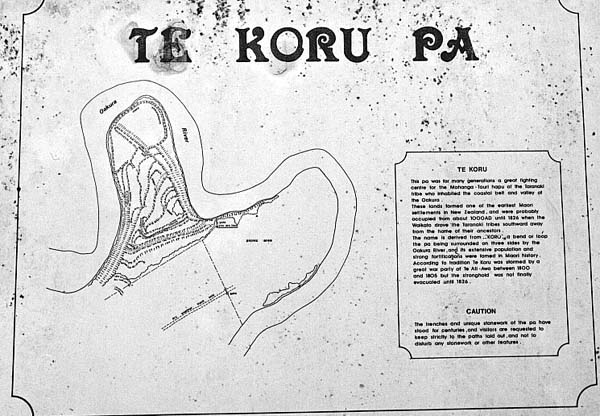
Here's
the official plaque, which sits by the gateway entry into Koru PA in, New Plymouth,
Taranaki. The plaque shows a drawing of the large archaeological site, with its
high stone walls, tiered multi-levels and souterrains (subterranean dwellings
or storerooms). This is a huge construction, requiring considerable labour and
stone working expertise to build, with some stone walls formerly extending upward
around 14 feet high. It's one of several, "stone PAs"(degree of stonework
dependent on the availability of suitable stone) surviving in the immediate vicinity...a
couple of which are huge. The plaque at Koru PA reads: These
lands formed one of the earliest Maori settlements in New Zealand and were probably
occupied from about 1000 AD until 1826 when the Waikato
drove the Taranaki tribes southward away from the home of their ancestors.
Eh
what?...don't you mean "occupied from about 1200-1300 AD" or thereafter
when 100-200 people, including 50 women, initiated "a
sudden surge of human impacts" upon the landscape of New Zealand?
Prof. Nigel Prickett, who did archaeological assessments and drawings of the Koru
site, leaves the door slightly ajar in suggesting that "some believe"
the site might not have been built until 1350 AD. Is he referring to Professor
John Flenley and his entourage, or the linguistics experts who place first arrivals
at 1200-1300 AD?
Did
Professor Flenley and the geneticists doing "remarkable detective work"
forget about the very early epoch construction of Koru PA and the many other large
stone walled structures in the region, several of which have "British-type"
standing stone observatories sitting adjacent to them? Let's weigh Prof. Flenley's
logic in the balance and see how it stacks up in the real world:
This is the central hubstone of the very
impressive Koru PA Observatory, which was surveyed and photographed recently.
The positions of about 70, mostly large, carefully placed boulder components,
lying in the long grass and bracken, were recorded and are undergoing AutoCAD
analysis. The ancient astronomers, who configured the site, set the central hubstone
to fix onto the benchmark cone position of Mt. Taranaki (now obscured by high
tree regrowth). The carefully chosen azimuth angle to Mt. Taranaki is 162-degrees,
for a return angle of 342-degrees. This duplicates the surveying methodology used
at Stonehenge, where the site was built in relation to 4 Station Stones. At Stonehenge
one Station Stone sits at 162-degrees azimuth and another at 342-degrees azimuth.
Preliminary analysis shows that the observatory at Koru PA contains the same navigational
and cyclic codes, etc., as Northern Hemisphere observatory sites. The hubstone
and all other components of the site have been pushed over and the theodolite
tripod (shown in the above picture) sits above the original standing position
of the hubstone. The central high plateau of Koru PA was configured to have Mt.
Taranaki sitting at 161.8-degrees azimuth. This coding was in mnemonic reference
to the PHI ratio, used all over the Northern Hemisphere in structures. The ratio
is 1.6180339 to 1.
The Koru PA hubstone can be located at S39-deg
07.812 minutes, E173-deg 59.467 minutes. Surveyors are encouraged to record the
positions of the 70 + components, some of which sit as far out as 172 feet from
the hubstone. Correct orientation for theodolites can be determined by taking
a fix onto Patuha trig, in clear weather, which sits at 212.6663-degrees. Alternatively,
the crown of Kaitake Peak sits at 208.6223-degrees. The site needs to be treated
with reverence and care as it's, potentially, many thousands of years old and
displays ancient European "cup stones" (for seasonal offerings) amidst
its hefty components.
What's this nonsense that, 'apart from hunting
and fishing they couldn't really get much to eat. Their tropical crops wouldn't
grow very well'. Eskimos have lived in unbelievably harsh environments, atop
the sterile pack-ice, for countless generations and fared very well. Aborigines
of Australia can go "walkabout" across stark, hostile deserts and still
find plenty to keep body and soul together. New Zealand is an abundant, verdant
country, where, in northern regions especially, the temperature fluctuations between
summer and winter are so small that individuals can acclimatize to walking around
without clothing in any season. It's a far cry from Tierra del Fuego, where Charles
Darwin observed a woman suckling her child as freezing sleet fell on their naked
bodies or people laid themselves down to sleep on frost covered ground, having
long since acclimatized to such appalling, harsh, frigid conditions.
The
experts seem to wish to "play down" the abundant South American tuber
staple crops, like the many potato varieties, that were easily cultivated in subtropical
zones. These tubers thrive in New Zealand's volcanic soils and were here long
before British colonisation, complete with accompanying and recognisable South
American type stone "potato God" statuettes... such as the large one
on Mokoia Island in Lake Rotorua, central North Island. Some stone potato God
statuettes were found around the Auckland Isthmus and are on display at the Auckland
War Memorial Museum. To suggest any ancient New Zealand association to South America
is anathema and forbidden in academic circles... despite overwhelming evidence
of a direct link to South America in antiquity.
Besides the many easily
grown varieties of potato crops, both taro and yams could be grown in large quantities
with apparent ease. Our waterway ditches or wetlands still provide a variety of
indigenous or formerly South American edible plants that are high in nutritional
value (like Raupo Bulrush...from South America via Easter Island) and these grow
naturally and profusely, without any need for cultivation. Maori, to this very
day, gather some of these "wild" plant species for their traditional
dishes. There was a wide variety of fern roots, cabbage trees, berries (Karaka,
Kawakawa) and edible bracken found almost everywhere within the forests, which
could be added to the inexhaustible fish and seal protein resources. Anyone with
basic bushcraft and marine environment hunter gatherer skills can still live reasonably
easily off the New Zealand landscape in any season and moreso in ancient times
when the unpolluted coastal or inland waterway food resources, especially, could
not possibly be depleted if basic conservation, common sense was adhered to. Inland
regions were very abundant in eels, river shrimp (kura) or large birds, as well
as protein rich edible grubs.
To suggest that Polynesians/ Melanesians,
used to living on a fish rich diet and on small islands in Western or Central
Polynesia, where plant and timber resources could be easily depleted, then, after
finding themselves in a large country with endless coastal or inland resources...
went hungry and faced starvation through lack of gathering skills... is ludicrous
in the extreme. New Zealand was an abundant breadbasket and veritable horn of
plenty, where one would never go hungry, unless lifestyles were unexpectedly disrupted
by a cataclysmic event, particularly bad weather, illness or siege warfare. If
nothing else, there were always pipi and toheroa shellfish, as well as crabs in
the sand of any beach... or mussels, oysters and paua (abalone) and kina alongside
some consumable species of sea snails, periwinkles, small fish (like rock cod,
etc.), which could be harvested from seaside outcrops or shallow pools at low
tide. There were also edible seaweeds.
According to the Herald article,
"1250-1300 is more in line with what early Maori scholars estimated on
the basis of whakapapa, or genealogies, which recorded between 18 and 25 generations
from the first canoes to the 19th century". This flies in the face of
certain Waitaha genealogies, which can apparently show something equivalent to
135-generations of continuous occupation, within New Zealand, up until the present
day.
The accumulated facts and basic up front logic show we're being
fed a crock...and you, quite reasonably, ask why?
I ask myself the same
question every day! The astronomical/ mathematical based structures and associated
evidence in the landscape alone are more than sufficient to utterly torpedo the
experts, but they don't want to know about it.
Martin.
From:
Lila Smith.
Date: June 20th 2003 16:23
Subject: Koru
PA
Dear Mr Doutre,
As a person who was born and bred in Taranaki,
I find your site most fascinating and truthful.
At the age of, now, 50 the
history of Taranaki, as I once knew it, has been distorted and taken out of context
so much that it is hardly recognisable.
After spending much time at Koru
Pa and visiting Europe, I firmly believe that your words are correct and that
Koru Pa is indeed non-Maori. The same goes also for Turu Turu Mokai.
I
find interesting the fact that Tara is not a Maori word and yet it is, in part,
the name of the province. I believe that it came from a leader who was not a Maori,
but of course, due to re-written history, it is now being told that he was.
What
concerns me more than anything is the fact that the Celts landed here many centuries
ago and this is well documented… so why is it that so many people refuse
to believe you regarding Celtic settlement in this country. While travelling throughout
Taranaki since my return to NZ, I myself have witnessed the standing stones, walls,
old pestle's and mortars amongst many artefacts that many landowners refuse to
give up and agree with you entirely about Koru Pa. Koru Pa is not a Maori settlement
or Pa and also the many large structures in the surrounding area are not Maori.
Regardless of who was in this country at what time, I feel that to disregard
a race, which was living here pre-Maori and throw it under the mat, refusing to
acknowledge their contribution to our history, is deplorable. Therefore, I congratulate
you for having the courage to find a way to take the truth to the world.
Funnily
enough my Great Great Great Aunt was Queenie Perrett, who was stolen from Lepperton,
Taranaki by the Maoris in 1870, so my interest as a child, as to how she lived,
made me question many older Kaumatua. The one thing that I remember more than
anything, IS THE FACT THAT THE OLDER MAORI STATED TIME AND TIME AGAIN, THAT
THE NAME OF THE PEOPLE THAT CAME BEFORE THEM WERE CALLED, BY MAORI, ' TANGATA
WHENUA..' The most unusual thing of all is that now Maori call themselves
the 'Tangata Whenua', when in fact they were not.
Carry on your wonderful
work, for in the end I am sure that the people of NZ, all, both Maori and Non-Maori
will benefit from what is obviously fact (your work) as opposed to re-written
fiction (by the NZ government and activists).
One thing about telling truth
is the fact that one cannot be caught out telling different versions, for the
truth never lies
Lila Smith
New Plymouth.
Hi Lila,
Finding
a Welsh/ Gaelic or Indian Vedic name like Taranaki in New Zealand isn't
much of a mystery, in consideration of who the long-term residents were that occupied
New Zealand before the Maori. Both "Tara" and "Nakshetra"
are terms that are inseparably connected in the very ancient Vedic astronomical
texts of India. In Vedic astronomy the term "Tara" meant star
and the most venerated constellation or stellar grouping was Orion, which
was associated with Lord Shiva. This attitude of placing Orion in high esteem
was shared by the Egyptians, who considered that Orion was heaven and the place
where Osirus dwelt. American Indian tribes of the southwest also venerated Orion,
and linguistics or religious beliefs show a direct cultural link between the American
Indians of, especially, the southwest (Hopi), with India. The Nakshetra was an
ancient 9 pointed compass that fixed onto the bright star positions surrounding
the belt stars of Orion.
Indian scholars, Deepak Bhattacharya &
P. C. Naik state:
The Vedic terms "Nakshetra" and "Tarakka"
both mean "Star" ("Tara"). It is our position that the study
of Tarakka / Nakshetra was among the primary scholastic activities of a bygone
civilization that conceived this nomenclature. http://www.grahamhancock.com/forum/DBhattacharya2.php?p=1
As
early New Zealand scholar, Edward Tregear, author of, The Aryan Maori (circa
1885) was able to point out, there are many words in the Maori language, which
have the same pronunciation and meaning as Indo-Aryan words. He was also able
to compare how religious beliefs of India were found in Maori culture.
The
European languages are, similarly, Indo-Aryan and also much influenced by Hebrew.
(See Phonological Similarities in Germanic And Hebrew, by Terry Marvin
Blodgett, Department of Languages, University of Utah, December 1981). The
religious beliefs of the Hebrews were much influenced by the early religious concepts
of India and many of these are represented by Bible stories and legendary biblical
figures.
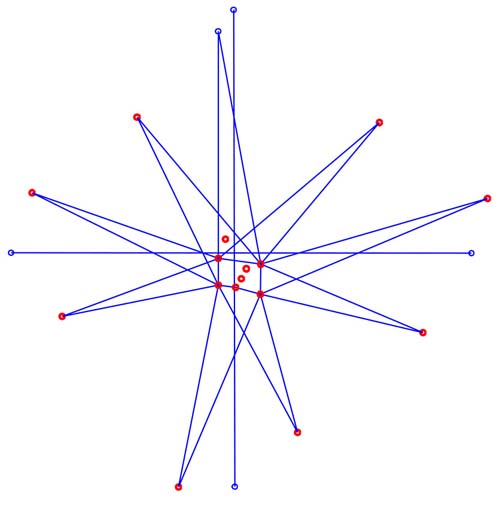
The
nine-pointed-star known as Nakshetra ("nine zones"). The Nakshetra is
also perfectly traceable in the sky, falling upon the bright stars that surround
the central cluster of Orion's belt stars. It was anciently used for navigation.
Researcher,
Joan Leaf, acquainted me with an old song or chant from Northern New Zealand,
which spoke of mountains of the north that "look" at each other. It
was immediately evident that the chant was indicating a huge circuit alignment,
spanning coast to coast, ranging from the Maungataniwha Range to Mt. Manaia on
the east coast, and to Maunganui Bluff on the west coast. The alignment configuration
is shaped quite like the Hyades constellation in Taurus.
Maori legends
and oral traditions speak of Mt. Taranaki having once dwelt in the centre of the
country with the mountains Ruapehu, Ngaruhoe and Tongariro, but a love triangle
and bitter feud broke out between the active volcanos Tongariro and Taranaki,
over beautiful, diminutive Mount Pihanga, resulting in Mount Taranaki being banished
to the coast, led by the Puniho stone, now on the Puniho Marae. As Taranaki sauntered
westward to the coast he gouged out the great chasm where the Wanganui River now
runs. So, we know that strong myths and legends exist, tying all of these volcanic
peaks together.
If one looks carefully, the layout of the mountains do indeed
suggest the configuration of Orion, with Mt. Ruapehu being Mintaka, Mt.
Ngaruhoe being Alnilam and Tongariro being Alnitak The position
of Mt. Taranaki would comply to that of Aliegbba. These stars are the central
defining stars of Orion. Sigma Orionis could well have been represented
by high country of "half height" to that of the volcanos, situated east
of Tongariro. The Anasazi star cities of the southwestern United States were set
out in this way, in veneration of Orion. (See http://azorion.tripod.com/article_frames.htm
)
This close "Orion" configuration relationship between the volcanic
peaks would not have gone unnoticed by the very adept astronomer/ surveyors of
ancient New Zealand, just as it didn't in Egypt, where the pyramids of the Giza
Plateau were set out in an Orion pattern. We know from Waitaha oral traditions
that a very long visual alignment went from Maunganui Bluff to the cone of Mt.
Taranaki , thus linking the Northern Alignment sequence of mountains with
the Taranaki Alignment sequence of mountains. A further linking alignment
went from the cone of Mt. Taranaki to Kapiti Island, then onto the mountain peaks
of the South Island.
Mount Taranaki was, without doubt, ancient New Zealand's
foremost navigational beacon. As an active volcano on the western sea coastline
facing Australia and Western Polynesia, it's smoky plume would have been visible
for a great distance over the horizon. In line with similar belief systems amongst
great civilisations, its imposing majesty would have invited religious veneration
and it would not be unreasonable to assume that it represented Shiva-Osirus-Orion
(which were largely synonymous), in conjunction with the other volcanic peaks
further inland. "Tara" in Maori means apex, fin or spine.
It
is my personal belief that "Taranaki" is a derivative of "Tara/
Nakshetra". The way the name for Mount Taranaki is used largely depends
on what route of migration you assign to the several "cousin" groups
who came to New Zealand in ancient times. Large pockets of Europeans once lived
in the now desolate Tarin Basin of China (hence the Caucasoid mummies of
Urumchi and their predecessors). Some of these moved north and south between Northern
India and China (hence the Aryans), whereas others ventured both west (The Middle
East, Near East and Europe) and east (The Bering Strait, Alaska, North America,
South America), with isolated pocket groups eventually finding New Zealand from
each direction.
Those moving back and forth between Northern India, the
Middle East, Near East and toward Europe took or shared religious beliefs, which
became the basis of Hebrew/ Israelite religions, as well as those of other cousin
nations of the Near Eastern region. Professor Terry Marvin Blodgett can trace
where each of the Hebrew based groups ended up, through various waves and during
various eras, in the phonetic fingerprints they introduced into each European
language. All European languages are largely Hebrew and Indo Aryan, with syllable
and consonant variations disguising their common root stock.
Extending the
migrations all the way to Britain, we have the "Tara" derived
names leaving a trail behind them every step of the way.
In consideration
of ancient Welsh/ Gaelic/ Breton/ Khumri variations on "Tara" we
have the following:
Koru PA is, essentially, an ancient Irish Rath/ Cashell. It has a large stone
observatory sitting beside it, which is set out for identifying both navigational
and astronomical principles...just like the standing stone observatories of ancient
Great Britain. This endeavor at Koru PA is perfectly in line with what is inferred
by Tara/ Nakshetra (or Mount Taranaki) the cone of which sits, in clear
view, at an azimuth angle of 161.80339-degrees from the high platform of
Koru PA (the PHI formula, used throughout Stonehenge, is 1 to 1.6180339).
Besides
all the stonework you've seen at Koru PA or elsewhere, consisting of standing
stone circles, walls, mortars and pestles, etc, etc,...even greenstone artefacts
in the same style as those retrieved from German graves or others of Continental
Europe and Britain, there are the hair samples. I can remember the platted red
and chestnut brown hair of the ancient European people, taken from the rock shelters
in the Waitakere Ranges, on display at Auckland War Memorial Museum. It was the
hair of Rua Taranaki's Patupaiarehe kinfolk...the long-term residents of
New Zealand.
Scholars probing definitions and development of the Maori term
"Pakeha" state the following:
The most likely derivation
seems to be from ‘Pakepakeha’ (George, 1999) mythical creatures who
are mischievous, human-like beings, with fair skin and hair who lived deep in
the forest, coming out only at night. (Biggs, 1988).
The ‘Pakepakeha’
are also linked to ‘Patupaiarehe’ by their fair skin and hair. The ‘Patupaiarehe’
had fair skin and beautiful voices, and gave people the secret of fishing with
nets. These creatures’ possess canoes made of reeds, which can change magically
into sailing vessels. The ‘Patupaiarehe’ can also be linked to Nahe’s
version of Pakeha as an abbreviation of ‘Paakehakeha’, gods of the ocean
who had the forms of fish and man (Biggs, 1988). See: http://maorinews.com/writings/papers/other/pakeha.htm
Whether one wants to call them Celts (a fairly late era European group... circa
1000 B.C.) or, more correctly, remnants of the Fomorians, Firbolg, Tuatha De Danann
or whatever, the fact remains that they were Europeans. They built Megalithic/
Neolithic Age type structures all over New Zealand, many of which were devoted
to astronomy or landscape coding of profound navigational principles. Those structures
are still in situ, all over New Zealand and are both easy to find and highly measurable.
I
can't believe that our archaeologists don't know they're there or can't see them,
unless they're incredibly stupid. I believe, instead that they see only what they're
allowed to see or only comment on subjects that they're allowed to comment on.
If they ever, actually, went out and did real archaeology, they'd commit career
suicide and be out of a job overnight. Like the ancient European, platted hair
samples that were once on display at the Auckland War Memorial Museum, the old
evidence is being eradicated or hidden away as effectively as possible and our,
once, "true" local scholars or scientists have long since been
replaced by a gaggle of compliant "social engineers". We're being subjected
to historical amnesia and forced to forget what we saw, read and knew as
historical truth only thiry years ago.
The fact that not one mainstream
archaeologist in the country has been outspoken about the disappearance of these
well known, well documented artefacts, shows that they'll prostitute their
integrity or the dignity of their profession to "play along with the deception"
and are worthy of nothing but our greatest contempt. We pay these people to tell
us the truth, but in return receive nothing back but deceit. The role of the modern
New Zealand, mainstream, archaeologist is to keep the public off the scent, such
that they never find the truth. The big deep, dark secret is that New Zealand
has had human inhabitants for many thousands of years, and that the long occupying
Patupaiarehe people were uru-kehu, kiri- puwhero Europeans.
Whereas, Samuel
Johnson, referring to rogue, manipulative politicians of his day said that (false)
"patriotism is the last refuge of a scoundrel", today it's (false)
"history is the last refuge of an opportunist liar and thief".
Martin.
From
Hiren
Date: Tuesday, 19 August 2003 09:06
Subject: Scandinavian,
or "other" European evidence.
I was speaking to a guy yesterday
who was doing some work for the Department of Conservation back in the late 80's
and early 90's. He mentioned the discovery of some old bones, which were very
quickly secreted out of sight by DOC, in light of the fact that they pre-dated
Maori inhabitation of NZ. He said the bones were of a tall race, possibly Scandinavian,
very tall, RED HAIR!
He also said that quite often when they were
doing field service work on transmitters, they would find burial plots or archaeological
evidence of pre-Maori settlement.
He confirmed DOC and some of the
Maori tribes are indeed working together to suppress information and destroy evidence.
What I would believe to be tantamount to the Taliban destroying the ancient statues
in Afghanistan.
Some friends of mine have become quite interested in NZ
history back to the Stonehenge ERA, and love the evidence you have been providing....
And in the great words of Mulder.. "The Truth is out there."
I am determined to find it.
Regards, Hiren.
Hi Hiren
These
concealment teams within DOC, working in collusion with certain suppressionist
iwi factions are a tragic fact of New Zealand life. The bones of the "tall
ones" with the red hair are the remains of our ancient European people, and
many of these skeletal remains predate the (circa 1300 AD) epoch of Maori by thousands
of years. A pox be upon those who wantonly disturb or destroy the remains of
our people! The lowlife scumbags who commit these criminal acts of desecration
do so to advance and promote their own selfish political agendas, which survive
only by hiding historical truth. These corridor creepers in DOC, or thieving iwi
creatures of the night, have to slink around in the shadows, as they can't work
openly and honestly in the light of day when RA is overhead. Theirs are works
of darkness and deception!
In a general sense, you would be correct that
some of the "tall ones" with the red, brown or blond hair were Scandinavian.
Essentially, some groups came to New Zealand from early Continental Europe (evidenced
by the kinds of stacked stone or astronomical use structures we're finding on
our landscape), whereas others might have come more directly from former European
homelands at the eastern base of the Mediterranean. Because our ancient European
ancestors shared the same heritage, expressed through measurement standards, beliefs,
cultural idiosyncrasies such as symbols, language, plinn rhythms, dance or musical
instruments like bagpipes and harps, astronomical/ navigational sciences, etc.,
many items tend to blend and blur into one related expression over several continents.
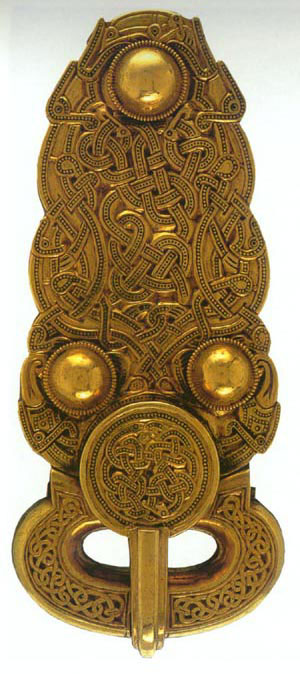
New
Zealanders will immediately recognise the stylised facial features shown on this
belt buckle from Sutton Hoo in England as very similar to what's seen in Maori
carving. A Scandinavian burial ship was also excavated on the same English site.
On the above artefact a "high hat" is depicted above the "Tiki-type"
face. The high hat or extended forehead representations of the "Tiki"
figurines is very prevalent in Oceania or Egypt, but somewhat less common in New
Zealand.
The strong cultural beliefs, which led to the creation of carved
greenstone Hei-Tiki ornaments or pendants, found within Maori culture and, more
generally, worn by women, are traceable to Europe and the Mediterranean, with
their varied, developing, pantheon of Gods. The Hei-Tiki is also found in Lima
Peru, Mexico, Palestine, and, especially, Southern Egypt.
The New Zealand
Hei-Tiki pendant and the squat wooden or stone "totem" statuettes from
which it is derived, is our local version of "Bes", the Southern
Egyptian God of pregnant women and the protector of mothers, children and the
home. When our ancient people abandoned Egypt to the encroaching desert and moved
into the verdant territories of Europe or elsewhere, early cultural symbolism,
such as that which led to religious concepts of "Bes", or similar
dwarf Gods, went with them. Bes and his counterparts in many lands became
a much loved, hairy and ugly, little bowlegged protector-entertainer God, found
in effigy statuettes or murals within homes/ community buildings from Egypt to
New Zealand...Bes/ Pan/ Puck/ Tiki/ Rongo.
Parallel words exist in many
ancient languages - Puca in Old English, Puki in Old Norse, Puke
in Swedish, Puge in Danish, Puks in Low German, Pukis in Latvia
and Lithuania. The pre-Christian Greeks represented him as a pipe playing, fun
loving, mischievous little dwarf God, who was a shepherd and who always questioned
authority. In Britain he was the God of the common people, also known as Robin
Goodfellow. Whether Pan of Greece or Puck of Britain, he retained
many attributes of the dwarf God Bes from Egypt, including associated symbolism.
In Egypt he protected mothers and children from snakes, scorpions and lions and
was often depicted as holding a snake in his left hand and a short sword cleaver
in his raised right hand. Some European depiction's of Puck show the snake
in the left hand. The Roman Christians turned this little Greek sator shepherd/
God of nature and fertility into the devil (Satan), and thus destroyed
the adoration and high esteem formerly vested in him by the common people.
Bes
of Egypt was an ugly little bowlegged dwarf with a large head, flat
nose and deeply creased "V" forehead brow. He had big bulging eyes,
a comically round protruding belly, was mostly depicted with his hands on his
hips or upper thighs, tongue poking out and genitals prominently displayed...
in exactly the same way as many Maori statues by portals
or gates. He was a fun little god who danced for the children, but
could turn terribly ferocious in their protection. Bes was very popular
with the common folk of ancient Egypt, as elsewhere, and was a household deity.
As mentioned, he developed into Puck to the Celts/ Britons or Pan
to the Greeks. He was a god of amusement, pleasure, music, dance and the ever
watchful protector of children. In some Mediterranean depiction's of Bes
he plays a harp, tambourine or flute. In Greece Pan played the pipes. A
relief in the tomb of Hatshepsut illustrates Bes being present at her birth
and other relief's on Egyptian walls suggest he was connected with childbirth.
He was often depicted as carrying a weapon for the protection of women
and children. In very early Egyptian relief's or statuettes the weapon is symbolised
by the hieroglyph "SA", which is shaped quite like a greenstone
Maori Patu/ Mere or club (also found in German graves and made of green
jade to the same general design configuration) The "SA" hieroglyph
means "protection". In latter Mediterranean depiction's the weapon is
a knife or short sword/ cleaver, which derived or developed from the Egyptian
"Ankh" symbol (a later development of "SA")...also
used to signify "protection". It is in direct consequence to this that
the squat, large headed, round bellied, genital protruding, bandy legged totem
statues at the entryways to Maori villages held a Patu/ Mere shaped club.
The club itself is symbolic of the Egyptian hieroglyph "SA", which means
"protection". The totem statues by portals or gates
are, therefore, strongly warning the ill intentioned, malevolent intruder, either
from the physical or spiritual realms, that the ever vigilant Bes is poised
ready to strike down any who come to do harm.
The fact that the New Zealand
totems often depict the Patu or Mere club, which is so similar to the earliest
"SA" hieroglyph representation, shows that the culture that,
originally, brought Bes to these shores instituted the oldest venerated
expression of Bes. In the Middle Kingdom of Egypt the "SA"
(protection) hieroglyph was used as a decorative element in jewelry and on magic
wands, and later, in the New Kingdom, it was often combined with the Ankh, Djed
and Tyet (Isis knot).
If a Maori statuette or totem, showing the typical,
short, bandy legged and big headed effigy, with the protruding tongue, genitalia
or round belly, as well as the heavily creased or "V" forehead...
and sporting a "SA" shaped weapon of protection, was placed into
an Egyptian or Libyan marketplace, even today, everyone would immediately recognise
it as a depiction of the God Bes. So, let's have a look at the old Egyptian
representations of "Bes" as he was portrayed throughout the ages.
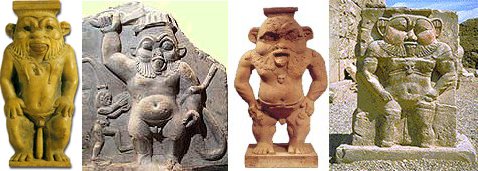
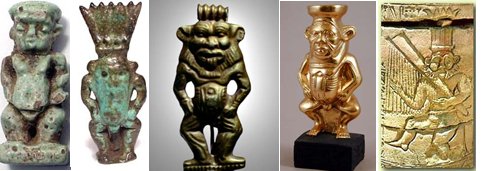
The
ugly, but beloved little dwarf god, Bes of Southern Egypt, protector of pregnant
women, mothers and children. He is shown here in typical stance, with his very
pronounced "V" brow or forehead, which became the "V" forehead
depression in the Tiki pendant. Generally, he would be shown with hands on hips
or upper thighs and bandy legged, which became the adjoined arms and leg features
on the Tiki pendant. He was often depicted as having big round "google"
eyes, another attribute of the Tiki design. Bes was "hairy", with the
hair ends of his beard curling into the (koru) spiral. Regionally, the greenstone
or whalebone Hei-Tiki pendant was a development from the more commonly carved,
New Zealand wooden totem, which stood adjacent to doorways or at gateway portals,
where anyone entering had to walk past "Bes" or between his legs. These
statue depiction's of New Zealand showed the tattooed "V" forehead (moko),
the cheek spirals, based upon the beard hair spirals of Bes, the big head with
the menacing expression, the protruding tongue (as shown above), The small body
with the protruding and rounded tummy, a pronounced belly button and conspicuously
exposed genitalia, arms and hands arching inward to the hips, upper thighs or
belly, as well as bandy little legs in an almost squatting stance. The last picture
in the above set, bottom far right, shows a column relief of Bes dancing for the
children.
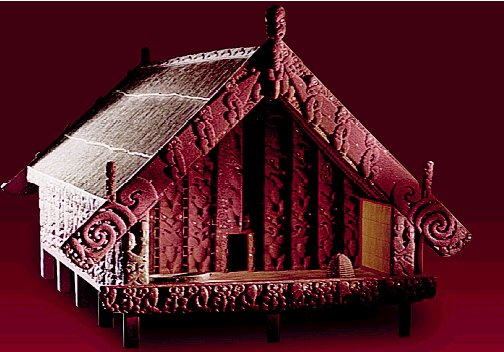
The
ugly, but beloved little god Bes, tongue protruding and looking menacing, showing
all of the same attributes as his Egyptian counterpart several continents and
oceans removed, guarding the portals of this ornate Patu-pai-arehe/ Maori pataka
building. He was the sentinel at the gateways to villages, often brandishing his
"SA" hieroglyph Patu/ Mere-club, the sign of protection to the women
and children of the village. When a baby smiled or laughed for no apparent reason,
it was because Bes had pulled a funny face. He was always there in times of illness,
childbirth or distress to comfort, help and protect.
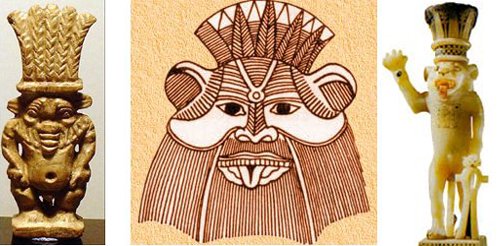
In
Tahiti, Hawaii and other regions of Polynesia the Bes statue representations tended
to retain the high hat of Bes, as seen in these Egyptian depiction's. Priests
of those regions continued to wear the high hats as a symbol of office. The figurine
to the left will be very recognisable to New Zealanders, as displaying the earliest
form of "Hei-Tiki" attributes. All three pictures show the poking tongue,
which is prominently displayed on early New Zealand wooden totems or stone effigies
of the bandy-legged little god. In the right hand picture Bes is accompanied by
the "SA" hieroglyph indicating "protection".
INTERNET
REFERENCE TO BES.
...He was a grotesque-looking
dwarf-god, but benign in nature. He was depicted wearing a plumed crown, normally
with a beard, and his broad, mask-like face was surrounded by a lion's mane and
ears. His tongue protrudes in a playfully aggressive manner. He looked like a
bandy-legged dwarf dressed in either a panther skin or a kilt, and a lion's tail
and he frequently carried musical instruments.
Protector
Together with Tawaret, his most important
function was as protector of childbirth, and amulets of these two deities were
immensely popular. His popularity covered common people´s homes as well
as the royal court. Images of him have been found on walls at some workmen´s
homes at Deir el-Medina, perhaps in rooms used for women and childbirth. He is
also seen painted on a frieze on a wall in the palace of Amenhotep III at Malkata.
There are decorations in the figure of Bes at everyday items like the footboard
of beds and on the headrests, on mirror handles and on cosmetic tools and implements.
There is a spell which is to be recited four
times over a clay dwarf which is placed on the crown of the head of a woman in
labour, to help against complications. In it Bes is called: 'great dwarf with
a large head and short thighs' and 'monkey in old age', here used as a means for
defense against the dangers of childbirth.
Bes´
ugliness and aggressive appearance was, in typical Egyptian manner, used as a
defense for the family and thought to ward off evil spirits and chase away serpents
and scorpions from the house. He was often depicted as the demon Aha, strangling
a snake in each hand.
Symbols
The
'Sa' hieroglyph, meaning protection, is often seen held by Bes, and he can also
be shown with his arms outstretched and with hawk´s wings suspended from
them. This conveys the solar symbolism of Heru of Behdety, not to link Bes with
that particular god, but it was used for magical purposes.
Musician,
merry-maker and bringer of good luck
Despite
brandishing a sword and having a ferocious appearance, Bes has a genial temperament
expressed through merrymaking and music. In the tomb of Queen Tiye´s parents,
in Dyn 28, Bes is seen striking a tambourine, and more than 1000 years later,
he still makes music, this time on a harp, in the temple of Het-Hert (Gr: Hathor)
on the island of Philae.
Bes is first and
foremost a deity connected with everyday life, but there are examples that he
also appeared in some form in the Underworld. In the mythological papyri of Dirpu,
the deceased comes to a gate guarded by a deity with the head of Anpu and the
body of knife-wielding, serpent-strangling Bes.
The
Late Period
He was also considered to
bring good luck and prosperity to married couples and their children, and especially
in the Late Period being connected to sexuality and childbirth. Therefore his
image is found on all of the mammisi (birth houses) during this period, and his
head is also seen above the Horus child on 'cippi' or stelae. It is also in this
period that there were 'incubation' or Bes-chambers built at Saqqara. Their walls
were lined with mud-plaster figures of Bes and a naked goddess, and it has been
suggested that perhaps pilgrims rested there, hoping to have healing dreams for
their sexual or fertile powers. In the Roman Period, Bes figurines exist where
he is clad in legionary garb. His popularity went beyond the borders of Egypt,
and his image is found at Kition in Cyprus, on an ivory plaque (ca 1200 bc.)and
Phoenician ivory craftsmen decorated the caskets and furniture of Nimrod in Assyria...
http://www.philae.nu/PerAnkh/perankhB.html
http://www.touregypt.net/featurestories/bes.htm
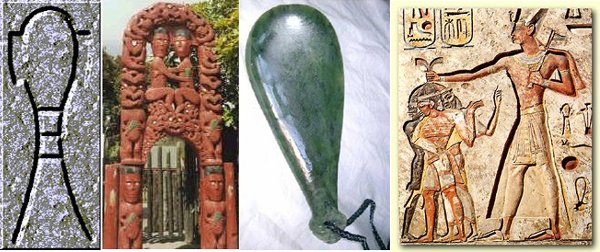
To
the left is shown the "SA" hieroglyph of Egypt, which means "protection".
This is the symbol that often accompanies mural or statuette depiction's of the
dwarf God Bes. Although Egyptologists can only speculate as to the origin of the
hieroglyph, or the object from which it was originally derived, it does, in fact,
bear a close resemblance to a hand club for close combat, with knife like edges
for cleaving in the skull of an adversary. Club weapons of this type, made of
wood, were found in various forms in Polynesia, Melanesia and Micronesia. The
design of the "SA" hieroglyph moves from a bulbous, club-like end to
a central handle or grip, which then flares or widens. Three horizontal lines
are seen in the "grip" or handle region.
With
the hieroglyph signifying "protection", it would not be unreasonable
to suggest that the object from which "SA" was originally derived was
a club, with knife or thinned edges to each side of the "business" end
of the weapon. This makes sense when one considers that late depiction's of Bes
showed him bearing a knife or short sword cleaver.
The
second picture shows a typical Maori gateway to a village. Guarding the gateway
are a series of "Bes"-like figurines in composed and placid, or angry
and threatening poses, with each bearing a greenstone "Patu"/ Mere weapon.
A ceremonial greenstone Patu/ Mere is shown in the third picture, in its simplest
or oldest design configuration. The overall shape of the Patu/ Mere is that of
the Egyptian "SA" hieroglyph (hieroglyph means a picture language, based
upon the shapes of real objects), which often accompanied portrayals of Bes. The
wooden or whalebone Patu/ Mere was a very effective close combat weapon for cleaving
in the skull of an opponent and was oftimes used by the Maori warriors for executing
captives, generally by a blow to the right side of the skull of a kneeling victim.
This researcher has seen skulls of the former Tangata Whenua, Turehu people, wherein
they died in this gruesome manner.
The
fourth picture shows Ramesses II preparing to dispense with his enemies, by a
blow that will cleave in the side of the skull. Below his left elbow is seen the
"SA" symbol of protection and below that yet another symbol that strongly
resembles the more simple shape of the Patu/ Mere. This panel of Ramesses II appears
to accentuate "protection" of the kingdom by the subjugation of enemies.
The
New Zealand or European greenstone/ jade examples of Patu/ Mere/ were only for
ceremonial usage, as the labour in carving and finishing such a precious, venerated,
hardstone object could take the lifetime of a single artisan. It was traditional
practice to carve two or three horizontal rings around the butt end of the handle
or grip of the New Zealand Patu/ Mere, consistent with the three lines appearing
on the "SA" hieroglyph. It was always the practice to add a wrist string
to the weapon, such that if it was knocked from the hand during battle, it would
not be lost, but could be quickly clasped anew. The flaring ends of the "SA"
hieroglyph might be indicating the wrist string or double strings of the club/
cleaver. It's interesting that the name for the weapon is "Patu" and
that the Maori umbrella terms for the earlier, kiri- puwhero and uru-kehu, "stonebuilder"
or "greenstone folk" was Patu-pai-arehe or Turehu.
A
famous Northern Chief at the time of the signing of the Treaty of Waitangi was
"Patuone". We know that the Maori word "Pa"
represents "fortress" and "Patu" a weapon of
protection. We also know that the "Turone" were a Continental
European Celtic tribe who venerated the deity Taranis or Taranaich (rendered
Taranaki or Tawhaki...the God of thunder and lightning in ancient Europe
or New Zealand). Perhaps the name of the Nga-Puhi chief "Pa-tuone"
contains parts of these several traditional meanings spanning oceans, related
to the earlier inhabitants, their language and beliefs.
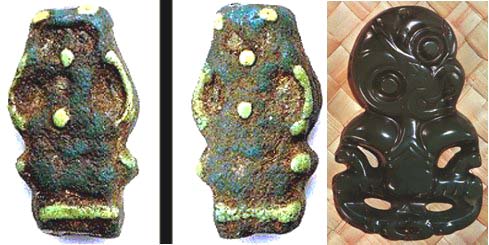
To
the right is seen front and rear pictures of an ancient Egyptian Bes figurine
in green/ blue turquoise stone, presumably from a domestic household where children
were present. To the right is the more popular and later form of the New Zealand
greenstone Tiki. This perfectly cut and shaped "commercial" Tiki is
the result of fabrication by diamond cutting tools, whereas the earlier, pre-colonial
Tiki's, produced by the greenstone folk, were the product of many years of very
hard labour. The earliest form of New Zealand Tiki had the somewhat more upright
head, like the Egyptian exemplar of Bes, or the ancient Mexican equivalent to
Bes/ Tiki.
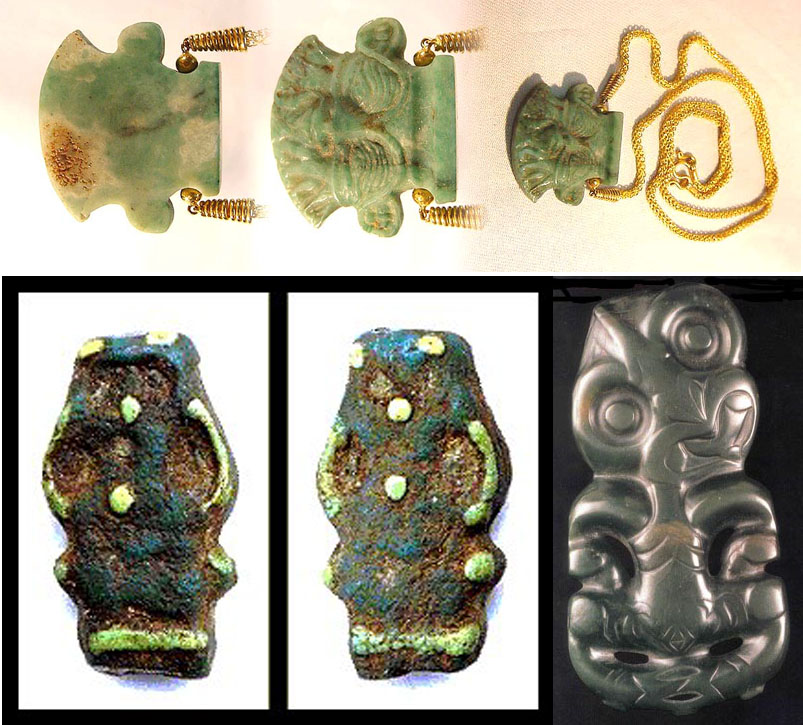
All
attributes of the dwarf God Bes, as found in Egypt and transferred by the migrations
of people in and around the Mediterranean or Europe, also found their way to the
Pacific and were preserved here for over three millenniums. In ancient Egypt it
was a practice to fashion the "big eyed" Bes head pendants using venerated
and precious green Nephrite (jade) hardstone, as shown in the third picture to
the right. The fourth picture shows yet another Greenstone (jade hardstone) Tiki
from New Zealand, this one held within the British Museum collection and taken
into their possession during the 1800's. Yet again, a strong cultural idiosyncrasy,
related to fashioning Bes figurines in the medium of green stone (Nephrite/ jade
or turquoise), is present at both ends of the Earth and separated by, possibly,
several millenniums of time. As mentioned, the second Egyptian statuette picture
from the left, showing a tongue protruding Bes with a high hat, is the most commonly
desplayed depiction/ form of "Tiki" in the Hawaiian Islands, as well
as other Island groups of Central or Western Polynesia.
REFERENCES
TO THE DWARF GOD IN ANCIENT MAORI NAMES.
In the ancient
Maori genealogical (whakapapa) charts several of the ancestral lines preserve
references to the dwarf God (Bes) in the names of ancestors. Maori personal names
always described an event, object, emotional response or religious reference in
the compound word that constituted the final rendition of the name. One of the
ancestors was Po-maru-ehi, (also rendered Po-maru-wehi),
which signifies (dwarf power of night). In the ancient tongue the terms
"ehi" or "wehi" made reference to the dwarf. In the Maori
language there is no "B" or "S" (no pun intended) and the
natural way of rendering a name like Bes or Bessie would be something equivalent
to Ehi or Wehi. Other names that appear to preserve some reference to the dwarf
God are: Wehi-nui-a-mamao (great fear of the distant), Maru-wehi (power
that trembles), Wehiwehi (dread), Taku-wehi (my fear), Po-maru-wehi
(crushed by fear), Kahu-ngunu (garment of the dwarf), Haka-matua
(dwarf parent), Rua-whewhe (pit of the dwarf), Maru-tauhea (tauwhea)
(influence of the dwarf). Names like Rua-tipua (tupua) (pit of the
goblin) or Whiro-tupua (goblin god) might also have once had reference
to Bes/ Rongo. There are many names of ancestors that include Rongo and
these seem to be based upon the South American route that the Bes traditions took
in their migration to New Zealand. Perhaps there was a late mixing of the South
American Rongorongo or Matuatonga potato God religious influences with the Egyptian
dwarf God traditions. The dwarf God statuettes at portals or gates are often called
Rongo.
Variations to these names, renditions or spelling related
to the dwarf God, his attributes or possessions, are due to his having several
names or that the above examples come from several different iwis (tribes) within
New Zealand. In the earliest days there was no "singular" Maori language
and although the spoken tongue seems to have been fairly consistent or understandable
around the country, there were the usual and expected variations in pronunciation
from region to region. Preserved, very ancient Waitaha language is purported to
be a significant departure from modern Maori and quite guttural in its delivery.
The Moriori language also had many significant, older language forms within it.
All
of the primary elements are present, which demonstrate that the most common statues
at Maori portals or village gateways are a regional expression of Bes, the dwarf
God of Southern Egypt. The local version of Bes could not include certain of his
faraway, Egyptian, protective cultural expressions, which related to the killing
of threatening lions, snakes and scorpions, as all such species were unknown to
or soon forgotten by the long-term populations of New Zealand.
THE
DANCE OF BES.
Masculine forms of the Maori haka were, without
doubt, in the earlier era of the Patu-pai-arehe people, dances of Bes,
where the performer attempted to encapsulate all of the facial characteristics
and physical attributes of the protective little Egyptian dwarf God. The dancer,
to this day, assumes a squat or bow legged position and stomps the ground with
all the force he can muster, slapping the thighs, rolling bulged out eyes, chanting
ferociously while grimacing and poking out the tongue. The fearsome display is
designed to let any challenger know that there will be no quarter given and that
unwarranted incursion will be met with ferocity unto death. This was the role
of Bes, the unflinching, uncompromising protector of women and children.
Some of these male hakas of yesteryear, within living memory, were commenced low,
at ground level, on one knee to accentuate the diminutive size of the dwarf god
or to imitate his portrayed design on the Hei-Tiki pendant. In recent years the
haka form that we in New Zealand and the rest of the world have become most acquainted
with is the one performed by our "All Blacks" football team.

Soldiers
of the Maori Battalion perform a haka in the Middle East during W.W.II. As in
all haka performances, correct execution of the dance requires that the performer
either squats low or assumes a position on one knee when commencing the dance.
Throughout the dance the stooped or squatting appearance is religiously maintained.
This can only be in homage to diminutive stature of the ferocious little dwarf
God Bes, down from whom the Maori haka dances of protection for the whanau have
come.
When a dignitary goes, formally, onto a Maori Marae
they are accorded the honour of a challenge, wherein they are to walk unperturbed
and without fear toward a weapon bearing warrior. The warrior seeks to intimidate
the dignitary and break their resolve, courage and composure by his threatening
antics, movements, grimaces and active dance. The warrior assumes a low, squatting
or springing position and bulges out the eyes in wild fury, the tongue darting
and the face grimacing. A token of peaceful intent is included in the ceremony,
which allows the warrior to withdraw. The "challenge" contains all of
the eye bulging, tongue lashing, symbolism of Bes, the dwarf god of Egypt,
whose responsibility it was to vet all comers and allow no visitor into the household
whose intent it was to do harm.
Despite the outwardly threatening
appearance of the Bes haka dance to the uninitiated, women and children
of the ancient tribes, or any who fully understood the benign tradition of Bes,
would see a pseudo serious/ comical aspect within the male haka and be both heartened
and amused by it. Knowing that the dancer was imitating Bes, the audience
would look to performers who excelled in providing the most pronounced bulging
of the eyes, extreme grimaces or facial, tongue whipping expressions. The comical
aspect of Bes-related dancing is, quite probably, preserved in many of
the haka dances of greater Polynesia. One of the most entertaining is the Tahitian
"mosquito" dance, a very lively performance where the dancers jump to
and fro, slapping themselves mercilessly. In another memorable Tahitian dance
the belly is rolled in a very amusing way that's guaranteed to bring the house
down with laughter. This hilarious ingredient of the dance, if it has a pedigree
back to the ancient Children of Poutini, would have been in homage to the comically
rotund, funny belly of Bes the comedian entertainer. It must take the performers
of this dance considerable practice to learn how to do the bizarre tummy-roll.
Belly-roll or women's "belly dancing" has long since been a traditional
norm in Egypt and its satellite countries and tolerated by the Muslim religious
leaders. The island of Moorea, opposite Papeete in the Tahitian group, was called,
'the island of the fairy folk with golden hair' (see Riddle of the Pacific,
by James Macmillan Brown).
It seems reasonable to assume
that these religious dance influences were passed down from the "Children
of Poutini" ...the uru-kehu (reddish or golden tinged hair) and kiri-puwhero
(light complexioned, reddish skin) offspring of Tangaroa/ Tangaloa who were, eventually,
chased out of the Islands of Polynesia and fled to sanctuary in New Zealand. They
were later found in New Zealand by the newly arriving Polynesian/ Melanesians,
who, for a time, had to live, 'under the 'mana of the Patu-pai-arehe' or
Turehu (the Children of Poutini). During this period of peace and sharing of unknown
duration, the Patu-pai-arehe people taught many of their cultural expressions
to Maori, including their Egyptian forms of moko chin tattooing for women or the
more extensive facial tattooing for men. Maori oral traditions tell us that the
art of Moko was learned from the Turehu, in such legends as the story of Mataora
(Maori) and Niwareka (Turehu). This account also shows that aspects of haka (dance)
were shared between the two cultures.
If Maori political activists
and their entourage of "in the pocket, Uncle Tom" archaeologist/ historian/
anthropologist/ geneticist lackeys, who'll bend the truth to suit the required
politics, continue to hold to the singular "Taiwanese" pedigree of all
Maori, then they automatically dispossess themselves of the most profound cultural
roots found within Maoridom. They can kiss "Good-bye" to many
Mediterranean patterns like the koru, chevron, etc., many stories-myths-traditions,
many religious expressions, most Gods such as Hei-Tiki or Rongorongo, much of
the symbolism and art, large segments of language roots, virtually all landscape
structures, all measurement standards and cairn marked geometries, most of the
edible or staple crops and flora from other lands like South America, styles of
dress, Egyptian/ Pictish pattern designs in facial tattooing and the deep-set
religious pedigrees within traditional dancing, chants or song, etc. Staple food
plants or other useful plants of Polynesia, originating in South America or Egypt
and extending to New Zealand, include: kumara, karaka berry, the cotton plant,
the bottle gourd, capsicum, banana, soapberry, tomato, papaya, pawpaw, pineapple,
manioc, maize, potato (about 23 varieties), cabbage tree (Yucca), the Nile valley's
bulrush or catspaw as well as taro (many varieties) from Egypt. Yam (a form of
potato) could have come from several regions, including Egypt and South America.
Most significant aspects of the culture never came from the
Taiwanese/ Malaya theatre of the world. To deny or render worthless and unmentionable,
large sections of one's ancestry, regardless of the fact that some forebears were
a beaten, captured and enslaved class without mana, is to demean the blood that
flows, whether by ancient consent or force, within one's own veins. Apart from
Waitaha and Moriori, who openly acknowledge and pay reverence to "all"
their distant ancestors, mainstream Maori cannot now claim the "stonebuilders"
as ancestors, having denied their memory for too long. The Patu-pai-arehe
have been, clearly, relegated to another ethnic category. They were the "strangers",
separate and distinct from, or classified as the enemies of, Maori, to be hunted
to extinction. Sadly, even the existence of Waitaha and Moriori is disclaimed
by this small, controlling political faction and gaggle of very vocal "spokespeople"
at the helm of Maoridom. No prior claimants to the country, predating Maori, are
tolerated and the very ancient regional histories of Waitaha or Moriori, etc.,
are not accorded formal recognition.
The early, traditional
or "religious" dances brought to Oceania by the European/ Mediterranean
people, thousands of years ago, would have included the dances of Bes for
the entertainment/ protection of mothers and children. By appearance, the surviving
"Bes" haka, which is, more-and-more, misinterpreted as, solely,
an "offensive" warrior challenge, rather than a "defensive"
protection dance, is becoming too dominant in New Zealand society and pushing
the more serene women's long and short poi dances into the half remembered background.
Many New Zealanders would like to see greater emphasis put back onto the women's
graceful dances, with the easy listening harmonies, or see more of the children's
stick and hand clap dances (See, Parallels in broad plot and fine detail
between a Greek myth and a Maori myth). E:\Taranaki\GreekMaoriMyth.htm
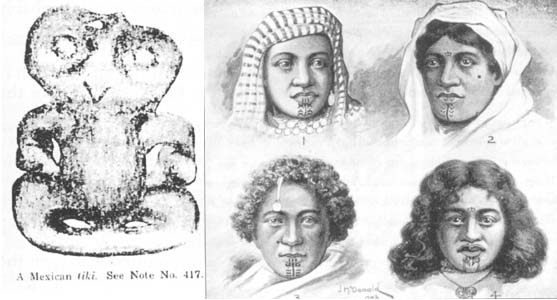
The
picture to the left is a Hei-Tiki found in Mexico. It is shown in volume XXXV
of the Journal Of The Polynesian Society under the title, Notes and
Queries (417) A Mexican Tiki. The Journal Of The Polynesian Society was, through
much of the 19th century and throughout the 20th century a very respected and
prestigious scientific periodical. The picture to the left shows 3 Egyptian women
(listed 1,2,3) with a Maori woman listed as (4). The Egyptian women are Assouan,
from Upper Egypt. All display chin, lip or forehead tattoos. This picture and
accompanying article appeared in The Journal Of The Polynesian Society,
Volume XIII - 1905.
The article and picture first appeared
in the Otago Witness newspaper and included the following commentary, 'The
London correspondent of The New Zealand Times says, - 'General Robley, the well
known authority upon Maori art, sends me a sketch that he made of Assouan villagers
now on view themselves at Earl's Court'.
'The sketch
shows that the married women of this tribe far up the Nile are tattooed in a manner
remarkably similar to that in which the Maori women used to be tattooed, namely
on the lips and chin and now and again on the forehead.... General Robley has
found on some of the earlier Egyptian mummies certain
ornamental designs, which have hitherto been considered purely Egyptian, but he
finds that they are identical to some of the most ancient
Maori patterns' (emphasis added).
See: The People Before, by Gary J Cook & Thomas J Brown pgs. 148,
150.
There is a very fine line of associated definition
in Maori nomenclature for statuette/ totem portrayed, physical attributes of the
"deformed" (haka) "stunted" (hakahaka) dwarf
god (Rongo/ Bes), in addition to the term for dance (haka)... when
compared to Egyptian fertility/ good-luck tattooing (Harquus).
The tattooing or body painting, ritually done
in ancient Egypt, was also strongly associated with dance. In Egypt, the concept
of a female version of Bes existed. This appears to have been case in New Zealand
also.
For further reference to traditional female facial
tattooing (Harquus) of North Africa/ Egypt
and it's Mediterranean environs see links extending from:
http://www.hennapage.com/henna/forum/messages/70857.html
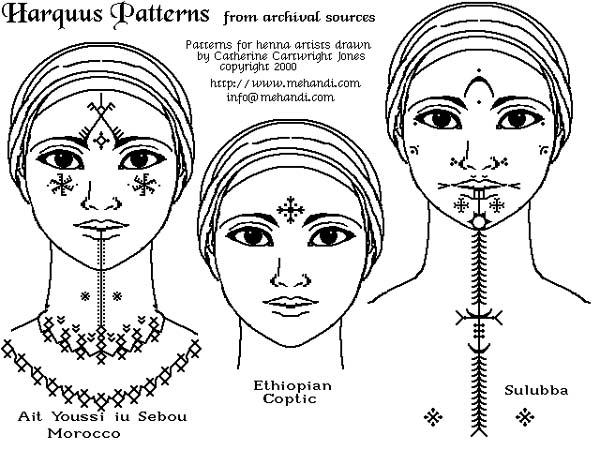
Bes related belly dancing for fertility/ good fortune/ protection, as found in
Egypt,... and incorporating facial tattooing (harquus),
as well as the more extensive body tattooing/ painting (henna)...
can be compared to the "worlds apart", Pacific patterns found on sacred
tapa cloths (painted prayers... rangoli)...
The religious symbolism found
in body tattooing/ dance, of both regions, is an inseparably linked, shared cultural
expression, spanning continents and oceans. Each aspect of dance or tattooing
stems from the same Egyptian/ Mediterranean/ Indian/ root source, originating
in the Tarin Basin/ Indus Valley/ Mediterranean/ European religious beliefs and
practices of remote antiquity. Because of it's very ancient pedigree, this form
of cultural symbolism or expression has been tolerated and allowed to persist
in otherwise "very strict" Muslim countries.
THE
DEMISE OF THE PATU-PAI-AREHE (EUROPEANS).
In the later
carnage, the villages of the Patu-pai-arehe and all possessions not hidden in
swamps or secreted away in the ground were taken over by the warriors and the
former people annihilated or forcibly enslaved. The Bes totems that guarded
the community meeting houses, patakas or village gates were, originally, Patu-pai-arehe.
The earliest greenstone Hei-Tiki pendants (Bes) and greenstone Patu/ Mere's
("SA" hieroglyph ceremonial protection symbols) were taken as
"prizes of conquest" from the children of Poutini, also known as the
greenstone folk and the white, flaxen haired offspring of Tangaroa, God of the
Sea. The Gods of these Patu-pai-arehe or "stonebuilders" were, Ammon
RA in squatting form (preserved in Moriori culture) Taranicus or Taranaich
(Taranaki)...Celtic God of thunder and lightning, Bes/ Puck the dancer/
protector of the home and the Egyptian supreme God RA (the Sun), in conjunction
with and embracing Nut (wife of the Sun-God... depicted as Rangi and
Papa). There were also bird headed Gods, which seemed to come to New Zealand
(via Easter Island) from South America and aquatic, serpent headed or dragon headed
Gods, which might have come from regions like Scandinavia.
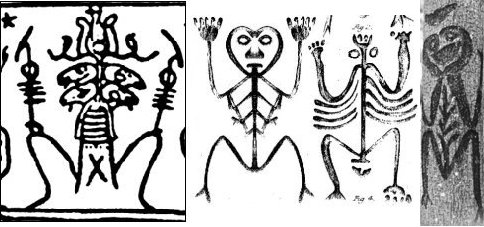
The picture to the left is the supreme God, Ammon RA, shown on the Egyptian
Hypocephalus funerary amulet. This is the ribbed, squatting god, which is a derivation
or metamorphised rendition from early astronomical geometry of Egypt. The three
figures to the right, showing the ribbed, squatting God, are Moriori from the
Chatham Islands of New Zealand. In the Egyptian example the 4 rams heads of Ammon-RA
look to the 4 quarters of the Earth and above the heads sits the plumed crown
of Ammon RA. In the 3 Moriori examples to the right of the Hypocephalus, an artistic
attempt, thousands of years removed from the Hypocephalus amulet depiction, very
adequately preserves the sideways looking faces and overhead crown of Ammon RA
the Sun God (see the middle one of the 3). The extreme right hand rendition is
a tree trunk carving and the "V" returning (chevron) placement of the
arms attempts to duplicate the balancing staffs on the knees of Ammon-RA. It is
a tremendous accomplishment of the Moriori Tohungas and learned Kaumatuas/ Kuias
to have preserved this symbolism, in distant isolation from the mother country
of Egypt, so well for so long. The Chehalis (Coast Salish) Indians of North America
preserved the symbolism in almost duplicate manner.
And so Hiren,
the "worst kept secret in town" relates to the "cover-up"
of the ancient European Patu-pai-arehe history and existence. Despite the
immoral extremes that a few scumbags in government departments and some iwi have
gone to in order to maintain secrecy and erase memory of these people, virtually
everyone knows about them. The futile attempts at socially engineering our history
and replacing it with a squeaky clean, plastic, Ronald McDonald version has been
an abject failure. Some of us are old enough to remember the old stories told
to us by the true Kaumatuas and aged Elders/ Kuias (the ones who received training
at the feet of their grandparents or within the Wharewaananga) ...rather than
the corporate Kaumatuas, who know about nothing except the colour of money.
Martin.
Continue









